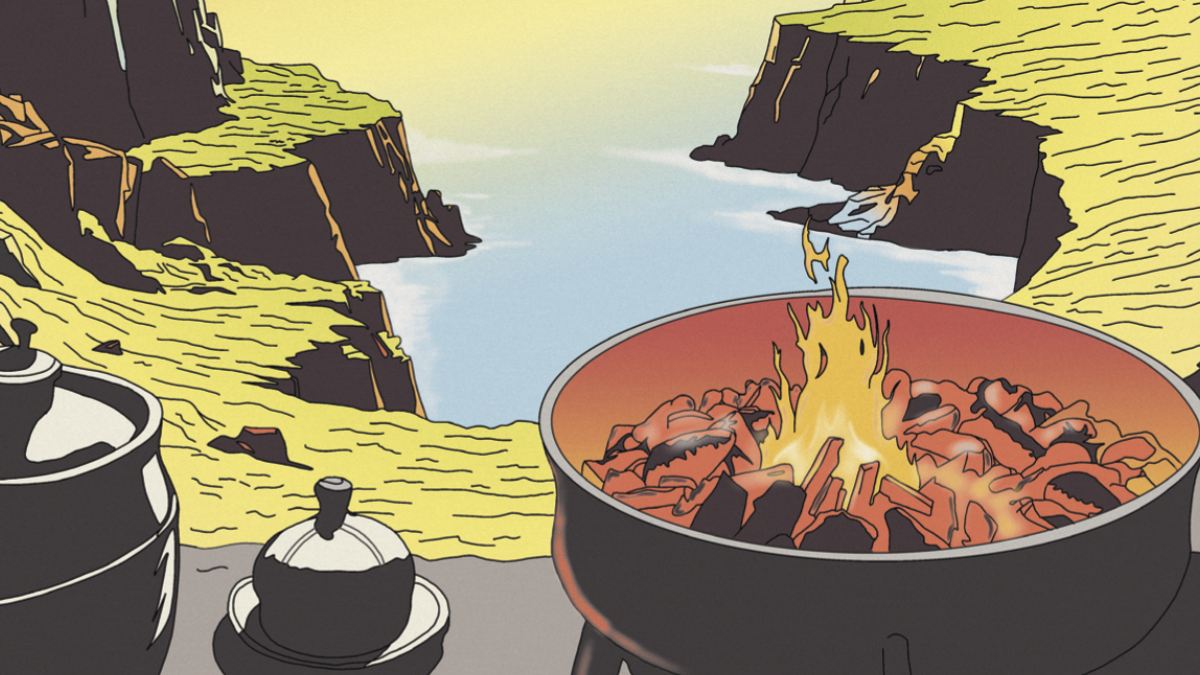Click here to read the Spanish version.
It is certain, according to anthropologists and historians, that the first forms of cooking, in addition to the direct cooking over the fire of pieces of hunted animals or fish, even vegetables, consisted of using the bellies or hides of animals as “containers” in which to cook various foods in water. Sometimes it was done by hanging bellies or skins over a lighted bonfire, other times by introducing stones heated in a pyre into the same containers with the ingredients to be cooked. The first procedure has been preserved until the 16th century in Ireland, where the meat of a beef was cooked inside its own hide even in that time which, when we speak of millennia, is actually very close to ours; the second has been preserved until our days in the kaiku of Euskadi, which is still used to boil the milk with which to make curd by introducing into the same -whose proportions are of the pot-, already filled with milk, the burning stones placed for this purpose in the fireplace. In this way the milk, besides being free of pathogens, acquires a burnt aroma very much to the taste of the euskaldunes, before adding to the kaiku the ferment to coagulate it.
Breasts and hides hung from a branch over the fire have very specific proportions, which copy the stew pot or the kaiku itself, and which seem to have inspired the oldest pots of the first kitchen in history, the one that was born in Mesopotamia and whose primitive utensils had shapes somewhat approximating an inverted truncated cone. Over time, the design evolved towards forms with parallel walls and the bottom equal to the mouth of the utensil. In their appearance close to our time their walls have at least a height equal to their diameter. As the volumes are very deceiving to the eye, it always seems that the height is greater than the diameter, but no, only in some occasions it is superior. This is the proportion of a pot that, in some cases, has a slightly convex shape, which facilitates the convection movements of the liquid and the temperature is uniform inside.

Ilustraciones: Debandolero
It is not necessary to go into complex descriptions of thermodynamics to explain the benefits of this relationship if you want to boil water or a soup in which you want almost the same temperature in all the liquid contained in the pot, or the lowest possible evaporation during the process of boiling a food in liquid. Our ancestors discovered the practical effects of thermodynamics in their cooking without needing to know or describe it, and only through experience, i.e., the method of trial and error. The convection movements of the liquid thanks to the heat of the fire inside the pot and the minimum evaporation of the liquid thanks to the small diameter of the utensil guarantee the best possible use of the energy of the fire and the boiling liquid.
Before the invention of the pressure cooker that we know, older than we think, the ceramic ones, already from the Middle Ages, constituted rudimentary pressure cookers, with the lid glued to its mouth with a thick cord of dough of wheat flour and water very worked to make it elastic. They thus avoided excessive evaporation of the liquid and, at the same time, by increasing the internal pressure, although minimal in this case, they raised the temperature of the liquid a little above that of boiling at atmospheric pressure.
There is another fundamental principle in nature and in the behavior of humans -except those who since they ceased to be hunter-gatherers belong to the wealthier classes of societies- which is based on the fact that in the course of natural or culinary processes the saving of matter, in ingredients, and of energy, in fuels for the fire, should be the maximum possible with the minimum waste and the best final result. In other words, the best food at the lowest cost. Fire, its fuels and ingredients have always been very expensive resources.
The knowledge of these truths allowed human beings to design cooking utensils with the shapes that respond most effectively to them. The first, it is evident, would be the pot of which we speak, because it is where the most primitive cooking is carried out. It is important to point out that in all human societies, even those that had never come into contact with each other – such as Eurasia and Africa with North and South America until the discovery of the latter continents – the solutions to similar problems are the same, almost identical. In all latitudes and from the most remote antiquity, the pot has these proportions: the height is at least equal to the diameter of its base, or even greater than this in some places or cases. It is inferred from all this that the stew pot has been like this since prehistoric times, and the relation between the diameter of its base and its height has not been modified; it has not been necessary, because the laws of physics, of fire or of the behavior of liquids before the heat provided by it have not been altered since the beginning of time (solid foods are composed of water between 60 and 90%).

Ilustraciones: Debandolero
The development of techniques led early on in primitive kitchens to the design of different utensils with different proportions to those of the pot. This reality, already present in the culture of Mesopotamia – as can be seen in Jean Bottéro’s work on the culture of the region, including culinary culture, in The Oldest Kitchen in the World – does not cancel anything of what has been said up to this point. Rather, it reaffirms it, because in the latter other conditions dictated by thermodynamics are met, which are essential for the application of more complex techniques developed by peoples throughout history and which are not simple cooking in abundant liquid.
Inside the first oven invented by man more than 5,000 years ago – the tinûru described by Bottéro – in addition to roasting bread in cakes stuck to its walls, meats and other foods skewered on skewers, other forms of cooking were carried out that we still practice in utensils of different proportions to those of the pot. The fact that we still use the oven for “cooking”, not exclusively for roasting, has its origins in antiquity. Due to its inverted vessel format, with the fire at the bottom and the mouth open at the top, the tinûru offered different temperatures depending on the height of its walls, where pots of different proportions, covered or not, could be placed on platforms attached to the projections of the walls for the preparation of stews, braises and other types of dishes at more or less mild temperatures.
Human culinary activity, therefore, has its roots in the same principles on which the most ancient cultures that first used fire to prepare their food in history were based.

